Financial Performance Management Report: Decision-Making and KPIs
VerifiedAdded on 2022/12/30
|12
|3372
|92
Report
AI Summary
This report delves into financial performance management, exploring environmental management accounting and its significance. Part 1 analyzes environmental costs, including preventing, appraisal, and failure costs, along with the benefits of managing these costs and the techniques used to control them, such as input/output analysis, activity-based costing, and life-cycle costing. The report also covers accounting methods for environmental costs, encompassing both internal reporting and financial statement integration. Part 2 focuses on the importance of decision-making in management accounting, emphasizing its role in cost analysis, budgeting, and planning. It examines planning tools like cash flow budgets and variance analysis, and discusses the relevance of budgetary control, including its impact on resource utilization and efficiency. Finally, the report highlights the role of Key Performance Indicators (KPIs) in improving financial performance and achieving financial sustainability, providing a comprehensive overview of financial management strategies.
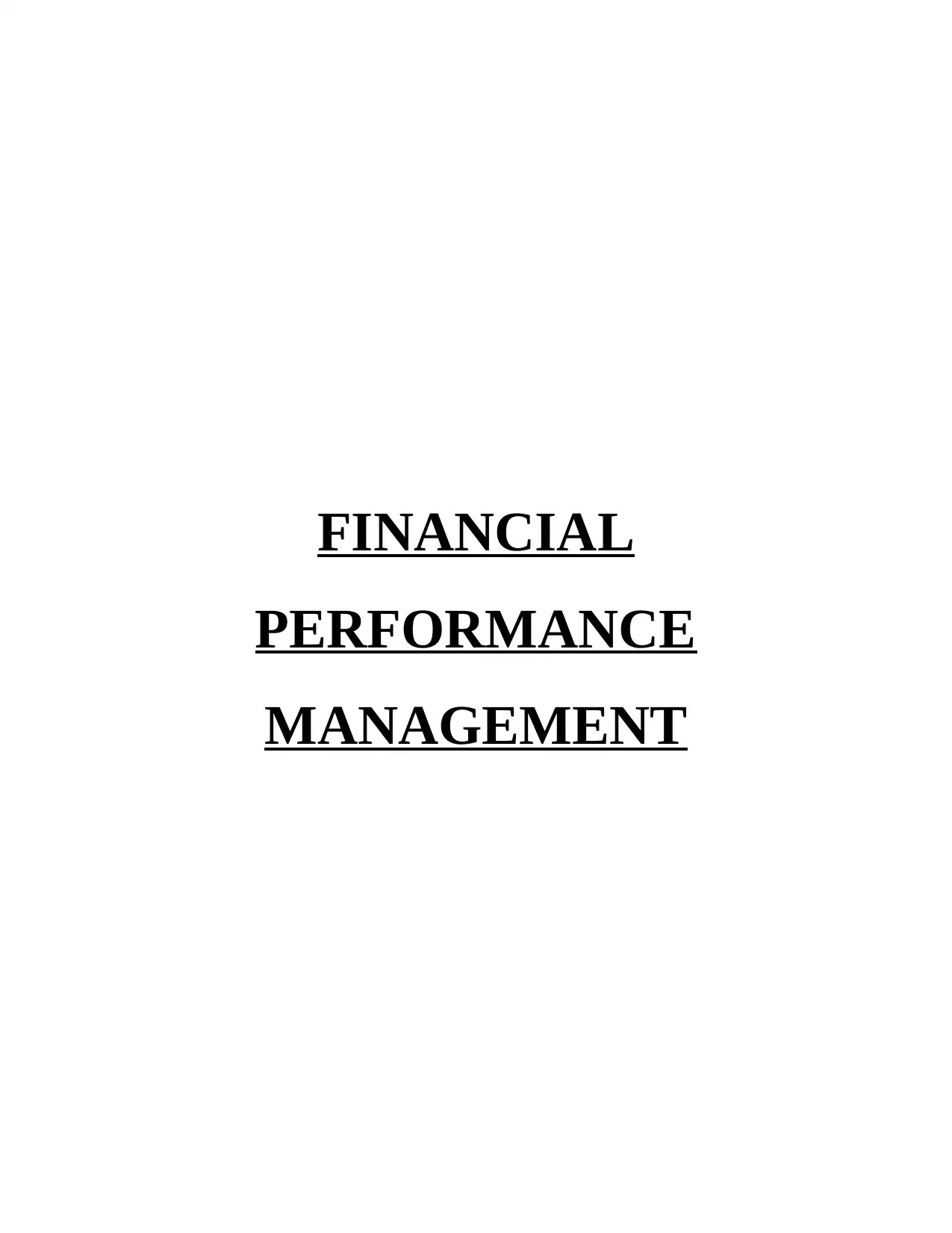
FINANCIAL
PERFORMANCE
MANAGEMENT
PERFORMANCE
MANAGEMENT
Paraphrase This Document
Need a fresh take? Get an instant paraphrase of this document with our AI Paraphraser
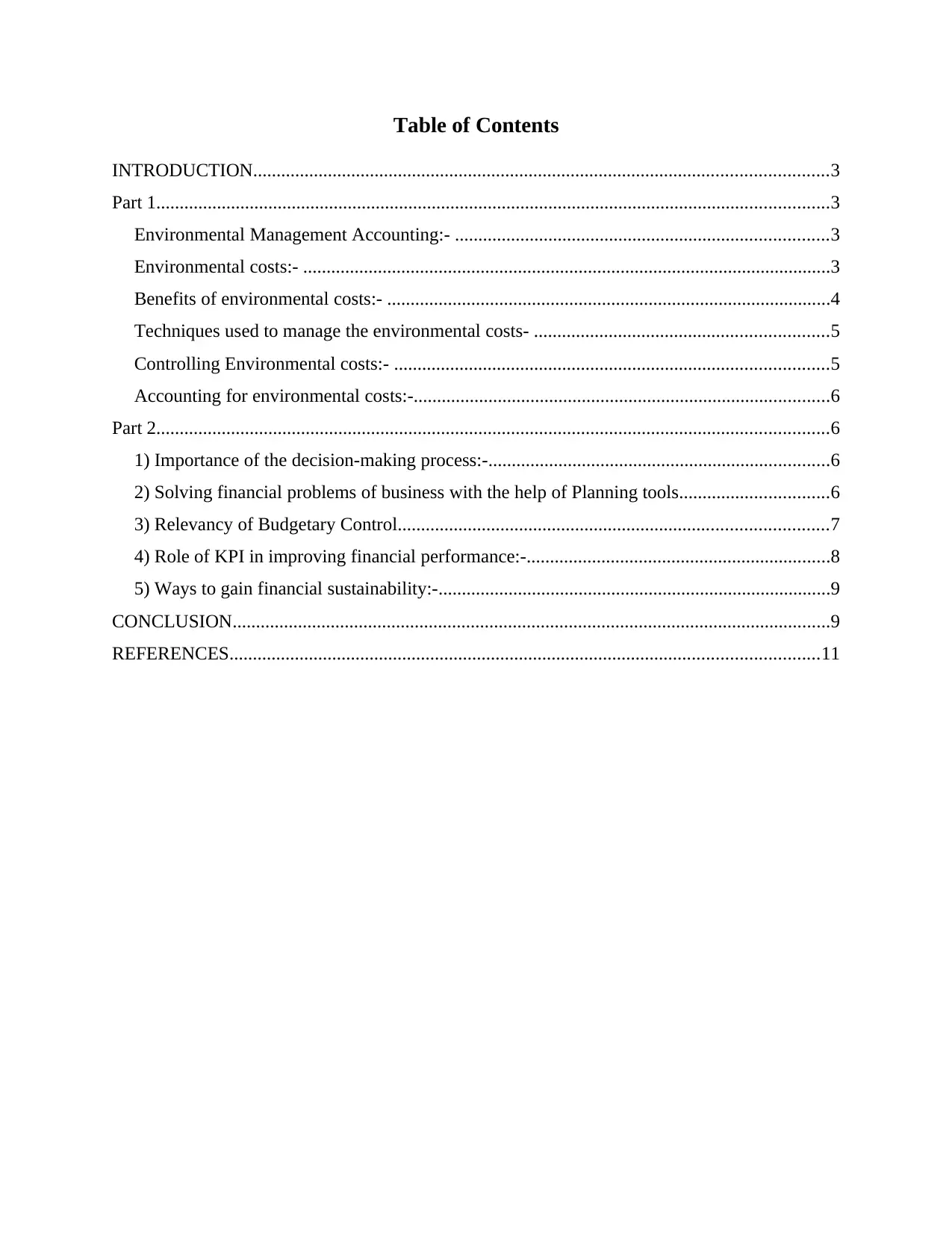
Table of Contents
INTRODUCTION...........................................................................................................................3
Part 1................................................................................................................................................3
Environmental Management Accounting:- ................................................................................3
Environmental costs:- .................................................................................................................3
Benefits of environmental costs:- ...............................................................................................4
Techniques used to manage the environmental costs- ...............................................................5
Controlling Environmental costs:- .............................................................................................5
Accounting for environmental costs:-.........................................................................................6
Part 2................................................................................................................................................6
1) Importance of the decision-making process:-.........................................................................6
2) Solving financial problems of business with the help of Planning tools................................6
3) Relevancy of Budgetary Control............................................................................................7
4) Role of KPI in improving financial performance:-.................................................................8
5) Ways to gain financial sustainability:-....................................................................................9
CONCLUSION................................................................................................................................9
REFERENCES..............................................................................................................................11
INTRODUCTION...........................................................................................................................3
Part 1................................................................................................................................................3
Environmental Management Accounting:- ................................................................................3
Environmental costs:- .................................................................................................................3
Benefits of environmental costs:- ...............................................................................................4
Techniques used to manage the environmental costs- ...............................................................5
Controlling Environmental costs:- .............................................................................................5
Accounting for environmental costs:-.........................................................................................6
Part 2................................................................................................................................................6
1) Importance of the decision-making process:-.........................................................................6
2) Solving financial problems of business with the help of Planning tools................................6
3) Relevancy of Budgetary Control............................................................................................7
4) Role of KPI in improving financial performance:-.................................................................8
5) Ways to gain financial sustainability:-....................................................................................9
CONCLUSION................................................................................................................................9
REFERENCES..............................................................................................................................11
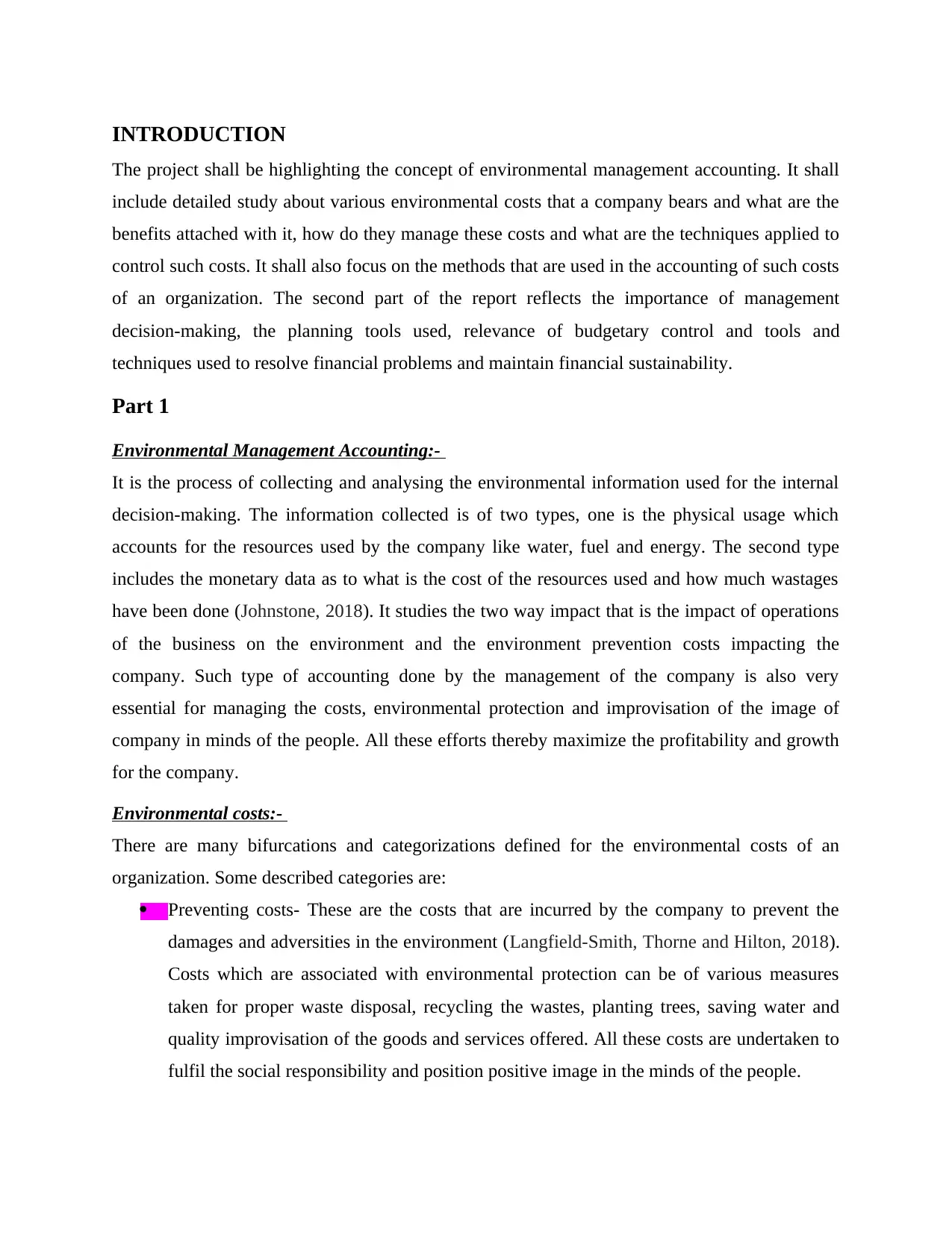
INTRODUCTION
The project shall be highlighting the concept of environmental management accounting. It shall
include detailed study about various environmental costs that a company bears and what are the
benefits attached with it, how do they manage these costs and what are the techniques applied to
control such costs. It shall also focus on the methods that are used in the accounting of such costs
of an organization. The second part of the report reflects the importance of management
decision-making, the planning tools used, relevance of budgetary control and tools and
techniques used to resolve financial problems and maintain financial sustainability.
Part 1
Environmental Management Accounting:-
It is the process of collecting and analysing the environmental information used for the internal
decision-making. The information collected is of two types, one is the physical usage which
accounts for the resources used by the company like water, fuel and energy. The second type
includes the monetary data as to what is the cost of the resources used and how much wastages
have been done (Johnstone, 2018). It studies the two way impact that is the impact of operations
of the business on the environment and the environment prevention costs impacting the
company. Such type of accounting done by the management of the company is also very
essential for managing the costs, environmental protection and improvisation of the image of
company in minds of the people. All these efforts thereby maximize the profitability and growth
for the company.
Environmental costs:-
There are many bifurcations and categorizations defined for the environmental costs of an
organization. Some described categories are:
Preventing costs- These are the costs that are incurred by the company to prevent the
damages and adversities in the environment (Langfield-Smith, Thorne and Hilton, 2018).
Costs which are associated with environmental protection can be of various measures
taken for proper waste disposal, recycling the wastes, planting trees, saving water and
quality improvisation of the goods and services offered. All these costs are undertaken to
fulfil the social responsibility and position positive image in the minds of the people.
The project shall be highlighting the concept of environmental management accounting. It shall
include detailed study about various environmental costs that a company bears and what are the
benefits attached with it, how do they manage these costs and what are the techniques applied to
control such costs. It shall also focus on the methods that are used in the accounting of such costs
of an organization. The second part of the report reflects the importance of management
decision-making, the planning tools used, relevance of budgetary control and tools and
techniques used to resolve financial problems and maintain financial sustainability.
Part 1
Environmental Management Accounting:-
It is the process of collecting and analysing the environmental information used for the internal
decision-making. The information collected is of two types, one is the physical usage which
accounts for the resources used by the company like water, fuel and energy. The second type
includes the monetary data as to what is the cost of the resources used and how much wastages
have been done (Johnstone, 2018). It studies the two way impact that is the impact of operations
of the business on the environment and the environment prevention costs impacting the
company. Such type of accounting done by the management of the company is also very
essential for managing the costs, environmental protection and improvisation of the image of
company in minds of the people. All these efforts thereby maximize the profitability and growth
for the company.
Environmental costs:-
There are many bifurcations and categorizations defined for the environmental costs of an
organization. Some described categories are:
Preventing costs- These are the costs that are incurred by the company to prevent the
damages and adversities in the environment (Langfield-Smith, Thorne and Hilton, 2018).
Costs which are associated with environmental protection can be of various measures
taken for proper waste disposal, recycling the wastes, planting trees, saving water and
quality improvisation of the goods and services offered. All these costs are undertaken to
fulfil the social responsibility and position positive image in the minds of the people.
⊘ This is a preview!⊘
Do you want full access?
Subscribe today to unlock all pages.

Trusted by 1+ million students worldwide
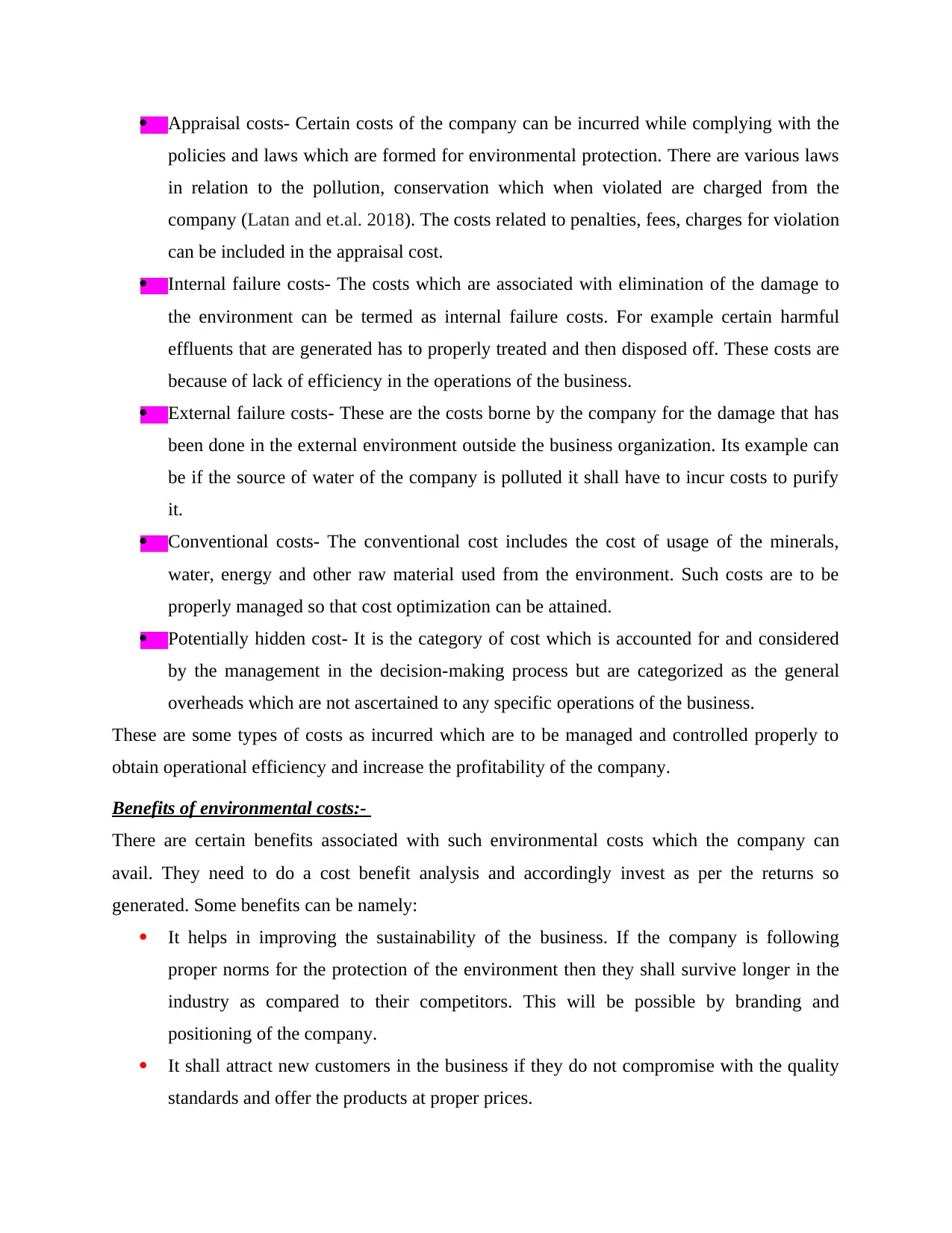
Appraisal costs- Certain costs of the company can be incurred while complying with the
policies and laws which are formed for environmental protection. There are various laws
in relation to the pollution, conservation which when violated are charged from the
company (Latan and et.al. 2018). The costs related to penalties, fees, charges for violation
can be included in the appraisal cost.
Internal failure costs- The costs which are associated with elimination of the damage to
the environment can be termed as internal failure costs. For example certain harmful
effluents that are generated has to properly treated and then disposed off. These costs are
because of lack of efficiency in the operations of the business.
External failure costs- These are the costs borne by the company for the damage that has
been done in the external environment outside the business organization. Its example can
be if the source of water of the company is polluted it shall have to incur costs to purify
it.
Conventional costs- The conventional cost includes the cost of usage of the minerals,
water, energy and other raw material used from the environment. Such costs are to be
properly managed so that cost optimization can be attained.
Potentially hidden cost- It is the category of cost which is accounted for and considered
by the management in the decision-making process but are categorized as the general
overheads which are not ascertained to any specific operations of the business.
These are some types of costs as incurred which are to be managed and controlled properly to
obtain operational efficiency and increase the profitability of the company.
Benefits of environmental costs:-
There are certain benefits associated with such environmental costs which the company can
avail. They need to do a cost benefit analysis and accordingly invest as per the returns so
generated. Some benefits can be namely:
It helps in improving the sustainability of the business. If the company is following
proper norms for the protection of the environment then they shall survive longer in the
industry as compared to their competitors. This will be possible by branding and
positioning of the company.
It shall attract new customers in the business if they do not compromise with the quality
standards and offer the products at proper prices.
policies and laws which are formed for environmental protection. There are various laws
in relation to the pollution, conservation which when violated are charged from the
company (Latan and et.al. 2018). The costs related to penalties, fees, charges for violation
can be included in the appraisal cost.
Internal failure costs- The costs which are associated with elimination of the damage to
the environment can be termed as internal failure costs. For example certain harmful
effluents that are generated has to properly treated and then disposed off. These costs are
because of lack of efficiency in the operations of the business.
External failure costs- These are the costs borne by the company for the damage that has
been done in the external environment outside the business organization. Its example can
be if the source of water of the company is polluted it shall have to incur costs to purify
it.
Conventional costs- The conventional cost includes the cost of usage of the minerals,
water, energy and other raw material used from the environment. Such costs are to be
properly managed so that cost optimization can be attained.
Potentially hidden cost- It is the category of cost which is accounted for and considered
by the management in the decision-making process but are categorized as the general
overheads which are not ascertained to any specific operations of the business.
These are some types of costs as incurred which are to be managed and controlled properly to
obtain operational efficiency and increase the profitability of the company.
Benefits of environmental costs:-
There are certain benefits associated with such environmental costs which the company can
avail. They need to do a cost benefit analysis and accordingly invest as per the returns so
generated. Some benefits can be namely:
It helps in improving the sustainability of the business. If the company is following
proper norms for the protection of the environment then they shall survive longer in the
industry as compared to their competitors. This will be possible by branding and
positioning of the company.
It shall attract new customers in the business if they do not compromise with the quality
standards and offer the products at proper prices.
Paraphrase This Document
Need a fresh take? Get an instant paraphrase of this document with our AI Paraphraser
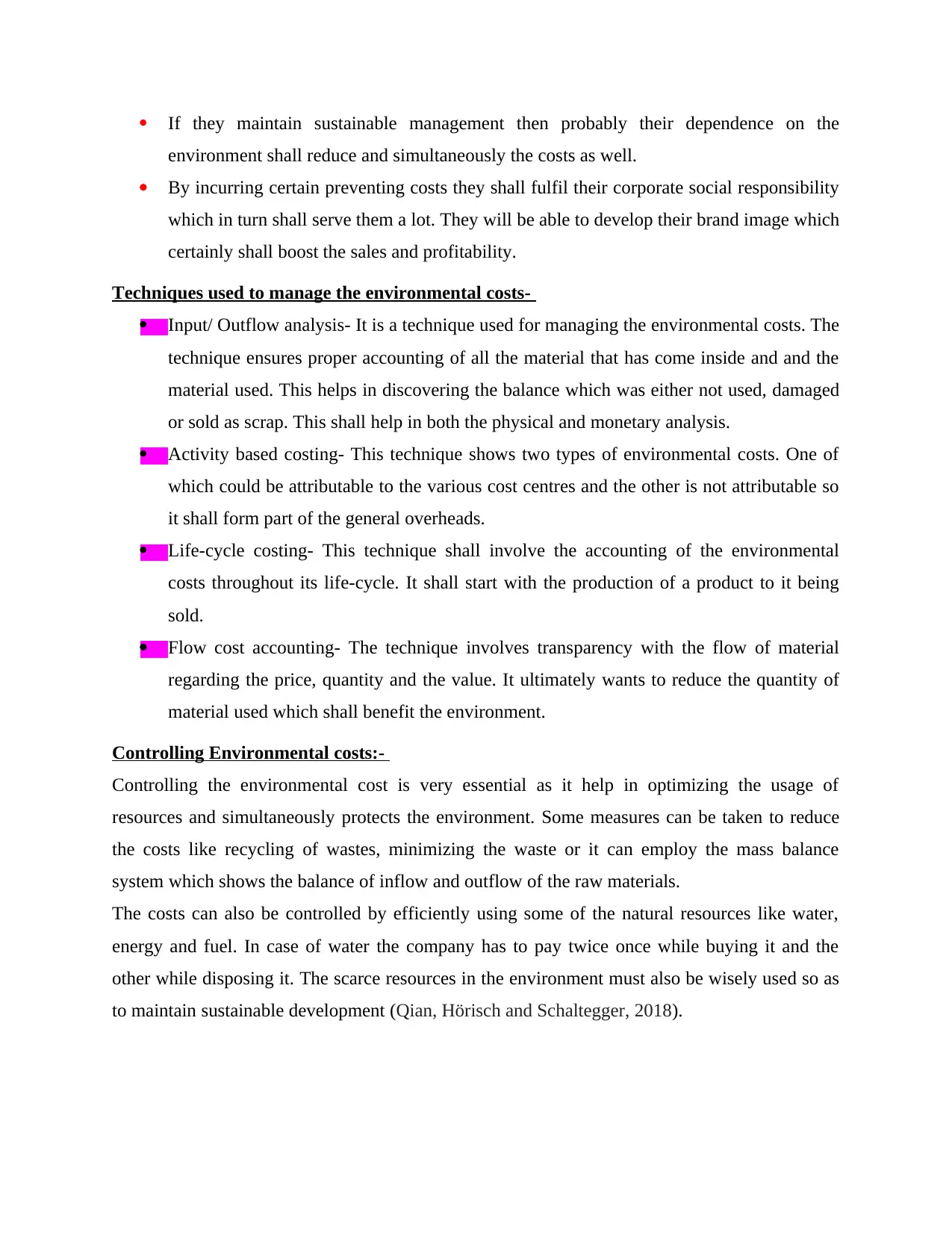
If they maintain sustainable management then probably their dependence on the
environment shall reduce and simultaneously the costs as well.
By incurring certain preventing costs they shall fulfil their corporate social responsibility
which in turn shall serve them a lot. They will be able to develop their brand image which
certainly shall boost the sales and profitability.
Techniques used to manage the environmental costs-
Input/ Outflow analysis- It is a technique used for managing the environmental costs. The
technique ensures proper accounting of all the material that has come inside and and the
material used. This helps in discovering the balance which was either not used, damaged
or sold as scrap. This shall help in both the physical and monetary analysis.
Activity based costing- This technique shows two types of environmental costs. One of
which could be attributable to the various cost centres and the other is not attributable so
it shall form part of the general overheads.
Life-cycle costing- This technique shall involve the accounting of the environmental
costs throughout its life-cycle. It shall start with the production of a product to it being
sold.
Flow cost accounting- The technique involves transparency with the flow of material
regarding the price, quantity and the value. It ultimately wants to reduce the quantity of
material used which shall benefit the environment.
Controlling Environmental costs:-
Controlling the environmental cost is very essential as it help in optimizing the usage of
resources and simultaneously protects the environment. Some measures can be taken to reduce
the costs like recycling of wastes, minimizing the waste or it can employ the mass balance
system which shows the balance of inflow and outflow of the raw materials.
The costs can also be controlled by efficiently using some of the natural resources like water,
energy and fuel. In case of water the company has to pay twice once while buying it and the
other while disposing it. The scarce resources in the environment must also be wisely used so as
to maintain sustainable development (Qian, Hörisch and Schaltegger, 2018).
environment shall reduce and simultaneously the costs as well.
By incurring certain preventing costs they shall fulfil their corporate social responsibility
which in turn shall serve them a lot. They will be able to develop their brand image which
certainly shall boost the sales and profitability.
Techniques used to manage the environmental costs-
Input/ Outflow analysis- It is a technique used for managing the environmental costs. The
technique ensures proper accounting of all the material that has come inside and and the
material used. This helps in discovering the balance which was either not used, damaged
or sold as scrap. This shall help in both the physical and monetary analysis.
Activity based costing- This technique shows two types of environmental costs. One of
which could be attributable to the various cost centres and the other is not attributable so
it shall form part of the general overheads.
Life-cycle costing- This technique shall involve the accounting of the environmental
costs throughout its life-cycle. It shall start with the production of a product to it being
sold.
Flow cost accounting- The technique involves transparency with the flow of material
regarding the price, quantity and the value. It ultimately wants to reduce the quantity of
material used which shall benefit the environment.
Controlling Environmental costs:-
Controlling the environmental cost is very essential as it help in optimizing the usage of
resources and simultaneously protects the environment. Some measures can be taken to reduce
the costs like recycling of wastes, minimizing the waste or it can employ the mass balance
system which shows the balance of inflow and outflow of the raw materials.
The costs can also be controlled by efficiently using some of the natural resources like water,
energy and fuel. In case of water the company has to pay twice once while buying it and the
other while disposing it. The scarce resources in the environment must also be wisely used so as
to maintain sustainable development (Qian, Hörisch and Schaltegger, 2018).
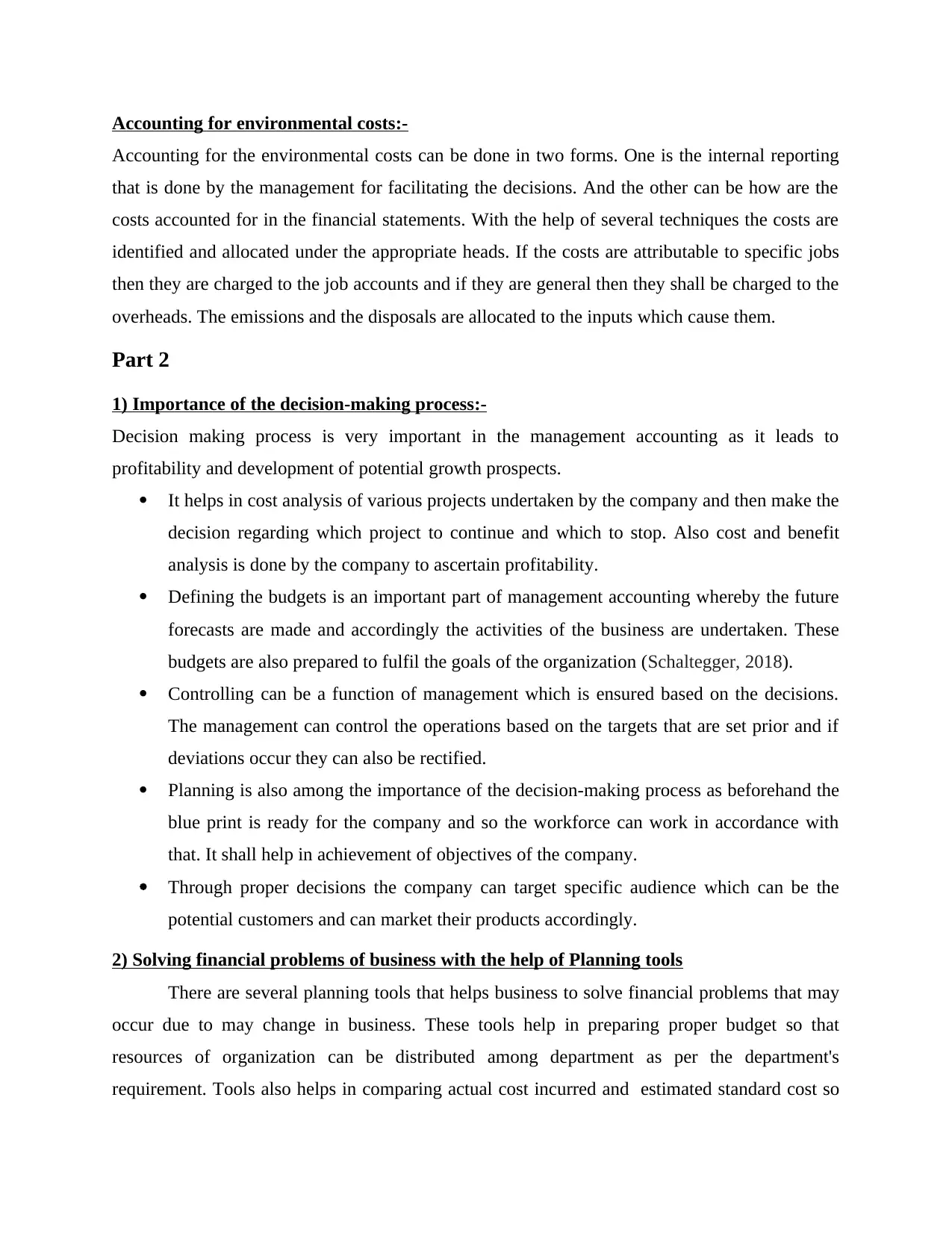
Accounting for environmental costs:-
Accounting for the environmental costs can be done in two forms. One is the internal reporting
that is done by the management for facilitating the decisions. And the other can be how are the
costs accounted for in the financial statements. With the help of several techniques the costs are
identified and allocated under the appropriate heads. If the costs are attributable to specific jobs
then they are charged to the job accounts and if they are general then they shall be charged to the
overheads. The emissions and the disposals are allocated to the inputs which cause them.
Part 2
1) Importance of the decision-making process:-
Decision making process is very important in the management accounting as it leads to
profitability and development of potential growth prospects.
It helps in cost analysis of various projects undertaken by the company and then make the
decision regarding which project to continue and which to stop. Also cost and benefit
analysis is done by the company to ascertain profitability.
Defining the budgets is an important part of management accounting whereby the future
forecasts are made and accordingly the activities of the business are undertaken. These
budgets are also prepared to fulfil the goals of the organization (Schaltegger, 2018).
Controlling can be a function of management which is ensured based on the decisions.
The management can control the operations based on the targets that are set prior and if
deviations occur they can also be rectified.
Planning is also among the importance of the decision-making process as beforehand the
blue print is ready for the company and so the workforce can work in accordance with
that. It shall help in achievement of objectives of the company.
Through proper decisions the company can target specific audience which can be the
potential customers and can market their products accordingly.
2) Solving financial problems of business with the help of Planning tools
There are several planning tools that helps business to solve financial problems that may
occur due to may change in business. These tools help in preparing proper budget so that
resources of organization can be distributed among department as per the department's
requirement. Tools also helps in comparing actual cost incurred and estimated standard cost so
Accounting for the environmental costs can be done in two forms. One is the internal reporting
that is done by the management for facilitating the decisions. And the other can be how are the
costs accounted for in the financial statements. With the help of several techniques the costs are
identified and allocated under the appropriate heads. If the costs are attributable to specific jobs
then they are charged to the job accounts and if they are general then they shall be charged to the
overheads. The emissions and the disposals are allocated to the inputs which cause them.
Part 2
1) Importance of the decision-making process:-
Decision making process is very important in the management accounting as it leads to
profitability and development of potential growth prospects.
It helps in cost analysis of various projects undertaken by the company and then make the
decision regarding which project to continue and which to stop. Also cost and benefit
analysis is done by the company to ascertain profitability.
Defining the budgets is an important part of management accounting whereby the future
forecasts are made and accordingly the activities of the business are undertaken. These
budgets are also prepared to fulfil the goals of the organization (Schaltegger, 2018).
Controlling can be a function of management which is ensured based on the decisions.
The management can control the operations based on the targets that are set prior and if
deviations occur they can also be rectified.
Planning is also among the importance of the decision-making process as beforehand the
blue print is ready for the company and so the workforce can work in accordance with
that. It shall help in achievement of objectives of the company.
Through proper decisions the company can target specific audience which can be the
potential customers and can market their products accordingly.
2) Solving financial problems of business with the help of Planning tools
There are several planning tools that helps business to solve financial problems that may
occur due to may change in business. These tools help in preparing proper budget so that
resources of organization can be distributed among department as per the department's
requirement. Tools also helps in comparing actual cost incurred and estimated standard cost so
⊘ This is a preview!⊘
Do you want full access?
Subscribe today to unlock all pages.

Trusted by 1+ million students worldwide

that variance in cost can be calculated to take major actions for improvement(Petera and
Šoljaková, 2020).
Cash Flow Budget tool
Cash is one of the most crucial issues of business because it is related to working capital
requirement and shortage of cash may affect the sustainability of entity. Cash flow budget is
p[art of budgeting activities that helps business to evaluate future figures of financial factors by
analysing trends. Through cash budget advanced and diversified strategies can be made for
future cash storages (McCalmont and et.al. 2017). It enables better resource distribution among
different department cash budget is an important planning tools that help business in solving
financial problems. Cash flow budget help company to analyse irrelevant cost and reduce it with
better planning and management of resources.
Variance Analysis Tool
It is set of some analytical arrangements that are available for business to compare the
pre budgeted standards against real outcomes. This tool is highly useful for financial and non
financial aspects and evaluating efficiency of business performance and accuracy of budgeting
practices. The tool is highly efficient in eliminating business financial problems. Through this
tool business can enable control over unnecessary expenses by way of setting some standards
relating to management of cost. This intern assists the company in managing the actual cost by
way of comparing the actual performance with standard cost and performance (McMullen and
Warnick, 2016).
3) Relevancy of Budgetary Control
Budgetary control helps senior management to ensure that spending limits are adequate,
it is a mechanism that proves that spending excessive may impact business adversely.
To use the forecasting techniques
It is relevancy of budgetary control that management accountant can use forecasting
techniques. Three departments that calculate the best estimation for future. Accounting
department provides old data, statistical department provides tools and techniques for forecasting
and management accounting uses this information for estimation of expenditure and revenues
under normal condition of business.
Effective Utilization of company's resources
Šoljaková, 2020).
Cash Flow Budget tool
Cash is one of the most crucial issues of business because it is related to working capital
requirement and shortage of cash may affect the sustainability of entity. Cash flow budget is
p[art of budgeting activities that helps business to evaluate future figures of financial factors by
analysing trends. Through cash budget advanced and diversified strategies can be made for
future cash storages (McCalmont and et.al. 2017). It enables better resource distribution among
different department cash budget is an important planning tools that help business in solving
financial problems. Cash flow budget help company to analyse irrelevant cost and reduce it with
better planning and management of resources.
Variance Analysis Tool
It is set of some analytical arrangements that are available for business to compare the
pre budgeted standards against real outcomes. This tool is highly useful for financial and non
financial aspects and evaluating efficiency of business performance and accuracy of budgeting
practices. The tool is highly efficient in eliminating business financial problems. Through this
tool business can enable control over unnecessary expenses by way of setting some standards
relating to management of cost. This intern assists the company in managing the actual cost by
way of comparing the actual performance with standard cost and performance (McMullen and
Warnick, 2016).
3) Relevancy of Budgetary Control
Budgetary control helps senior management to ensure that spending limits are adequate,
it is a mechanism that proves that spending excessive may impact business adversely.
To use the forecasting techniques
It is relevancy of budgetary control that management accountant can use forecasting
techniques. Three departments that calculate the best estimation for future. Accounting
department provides old data, statistical department provides tools and techniques for forecasting
and management accounting uses this information for estimation of expenditure and revenues
under normal condition of business.
Effective Utilization of company's resources
Paraphrase This Document
Need a fresh take? Get an instant paraphrase of this document with our AI Paraphraser

Budgetary control helps the company to use its monetary resources effectively. Company
can stop misusing its resources only if someone can stop and explain the proper utilization of
those resources (Gooneratne and Hoque, 2016.).
Enhance Efficiency
It is an effective way to control cost and waste of material it will lead to economic and
business efficiency. It is one of the most important relevancy of budgetary control.
Delegation of authority
Budgetary control encourages delegation of authority. It fixes the limit within which
delegated authority can work. Subordinates and executive can exercise initiative and judgement
with budgetary limit (Schmitz, 2020. ).
Integration of personal efforts with organization goals
Budgeting helps the manager in integrating personnel efforts with organization goal. It is
very important tool that serves business effectiveness and efficiency.
4) Role of KPI in improving financial performance:-
The financial key performance indicators like the cash flow, revenue, cost, profits etc are
interrelated with the non financial key performance indicators. Be it financial or the non-
financial key performance indicators, the sole motive lies in the improvisation of the financial
performance. The various ratios like inventory turnover, debt equity, accounts receivable and
accounts payable can be included in the financial key performance indicators. Such KPI's can
prove to be very helpful in the performance up gradation as if the resources are optimized and
managed it can lead to better profitability. If the cash is recovered on time then it can benefit to
the whole working cycle and also if there is idle cash with the organization it can invest it
further. The debt equity ratio should also be perfect within an organization so as to balance the
risk profile of the company.
The current and the quick ratio should also be managed properly as they show the liquidity
position of the company. If they are stabilized means the company shall be able to meet its short
term obligations.
The cash flow management shall also be proper wherein all the inflows and outflows of the cash
are properly accounted for. It helps in knowing the surplus and deficit of cash in hand in the
company. If there is surplus you can invest and if there is deficit you need to arrange it.
can stop misusing its resources only if someone can stop and explain the proper utilization of
those resources (Gooneratne and Hoque, 2016.).
Enhance Efficiency
It is an effective way to control cost and waste of material it will lead to economic and
business efficiency. It is one of the most important relevancy of budgetary control.
Delegation of authority
Budgetary control encourages delegation of authority. It fixes the limit within which
delegated authority can work. Subordinates and executive can exercise initiative and judgement
with budgetary limit (Schmitz, 2020. ).
Integration of personal efforts with organization goals
Budgeting helps the manager in integrating personnel efforts with organization goal. It is
very important tool that serves business effectiveness and efficiency.
4) Role of KPI in improving financial performance:-
The financial key performance indicators like the cash flow, revenue, cost, profits etc are
interrelated with the non financial key performance indicators. Be it financial or the non-
financial key performance indicators, the sole motive lies in the improvisation of the financial
performance. The various ratios like inventory turnover, debt equity, accounts receivable and
accounts payable can be included in the financial key performance indicators. Such KPI's can
prove to be very helpful in the performance up gradation as if the resources are optimized and
managed it can lead to better profitability. If the cash is recovered on time then it can benefit to
the whole working cycle and also if there is idle cash with the organization it can invest it
further. The debt equity ratio should also be perfect within an organization so as to balance the
risk profile of the company.
The current and the quick ratio should also be managed properly as they show the liquidity
position of the company. If they are stabilized means the company shall be able to meet its short
term obligations.
The cash flow management shall also be proper wherein all the inflows and outflows of the cash
are properly accounted for. It helps in knowing the surplus and deficit of cash in hand in the
company. If there is surplus you can invest and if there is deficit you need to arrange it.
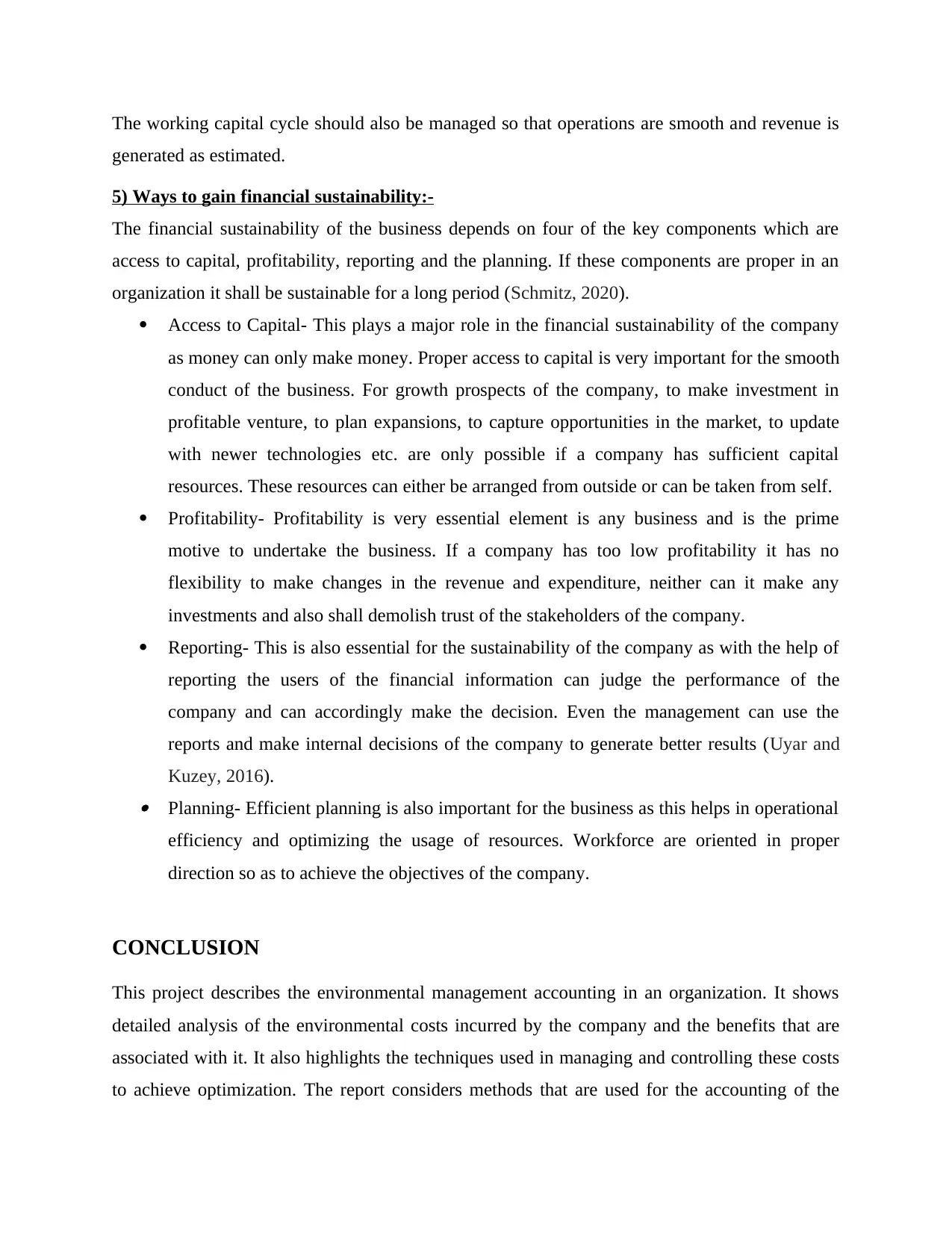
The working capital cycle should also be managed so that operations are smooth and revenue is
generated as estimated.
5) Ways to gain financial sustainability:-
The financial sustainability of the business depends on four of the key components which are
access to capital, profitability, reporting and the planning. If these components are proper in an
organization it shall be sustainable for a long period (Schmitz, 2020).
Access to Capital- This plays a major role in the financial sustainability of the company
as money can only make money. Proper access to capital is very important for the smooth
conduct of the business. For growth prospects of the company, to make investment in
profitable venture, to plan expansions, to capture opportunities in the market, to update
with newer technologies etc. are only possible if a company has sufficient capital
resources. These resources can either be arranged from outside or can be taken from self.
Profitability- Profitability is very essential element is any business and is the prime
motive to undertake the business. If a company has too low profitability it has no
flexibility to make changes in the revenue and expenditure, neither can it make any
investments and also shall demolish trust of the stakeholders of the company.
Reporting- This is also essential for the sustainability of the company as with the help of
reporting the users of the financial information can judge the performance of the
company and can accordingly make the decision. Even the management can use the
reports and make internal decisions of the company to generate better results (Uyar and
Kuzey, 2016). Planning- Efficient planning is also important for the business as this helps in operational
efficiency and optimizing the usage of resources. Workforce are oriented in proper
direction so as to achieve the objectives of the company.
CONCLUSION
This project describes the environmental management accounting in an organization. It shows
detailed analysis of the environmental costs incurred by the company and the benefits that are
associated with it. It also highlights the techniques used in managing and controlling these costs
to achieve optimization. The report considers methods that are used for the accounting of the
generated as estimated.
5) Ways to gain financial sustainability:-
The financial sustainability of the business depends on four of the key components which are
access to capital, profitability, reporting and the planning. If these components are proper in an
organization it shall be sustainable for a long period (Schmitz, 2020).
Access to Capital- This plays a major role in the financial sustainability of the company
as money can only make money. Proper access to capital is very important for the smooth
conduct of the business. For growth prospects of the company, to make investment in
profitable venture, to plan expansions, to capture opportunities in the market, to update
with newer technologies etc. are only possible if a company has sufficient capital
resources. These resources can either be arranged from outside or can be taken from self.
Profitability- Profitability is very essential element is any business and is the prime
motive to undertake the business. If a company has too low profitability it has no
flexibility to make changes in the revenue and expenditure, neither can it make any
investments and also shall demolish trust of the stakeholders of the company.
Reporting- This is also essential for the sustainability of the company as with the help of
reporting the users of the financial information can judge the performance of the
company and can accordingly make the decision. Even the management can use the
reports and make internal decisions of the company to generate better results (Uyar and
Kuzey, 2016). Planning- Efficient planning is also important for the business as this helps in operational
efficiency and optimizing the usage of resources. Workforce are oriented in proper
direction so as to achieve the objectives of the company.
CONCLUSION
This project describes the environmental management accounting in an organization. It shows
detailed analysis of the environmental costs incurred by the company and the benefits that are
associated with it. It also highlights the techniques used in managing and controlling these costs
to achieve optimization. The report considers methods that are used for the accounting of the
⊘ This is a preview!⊘
Do you want full access?
Subscribe today to unlock all pages.

Trusted by 1+ million students worldwide
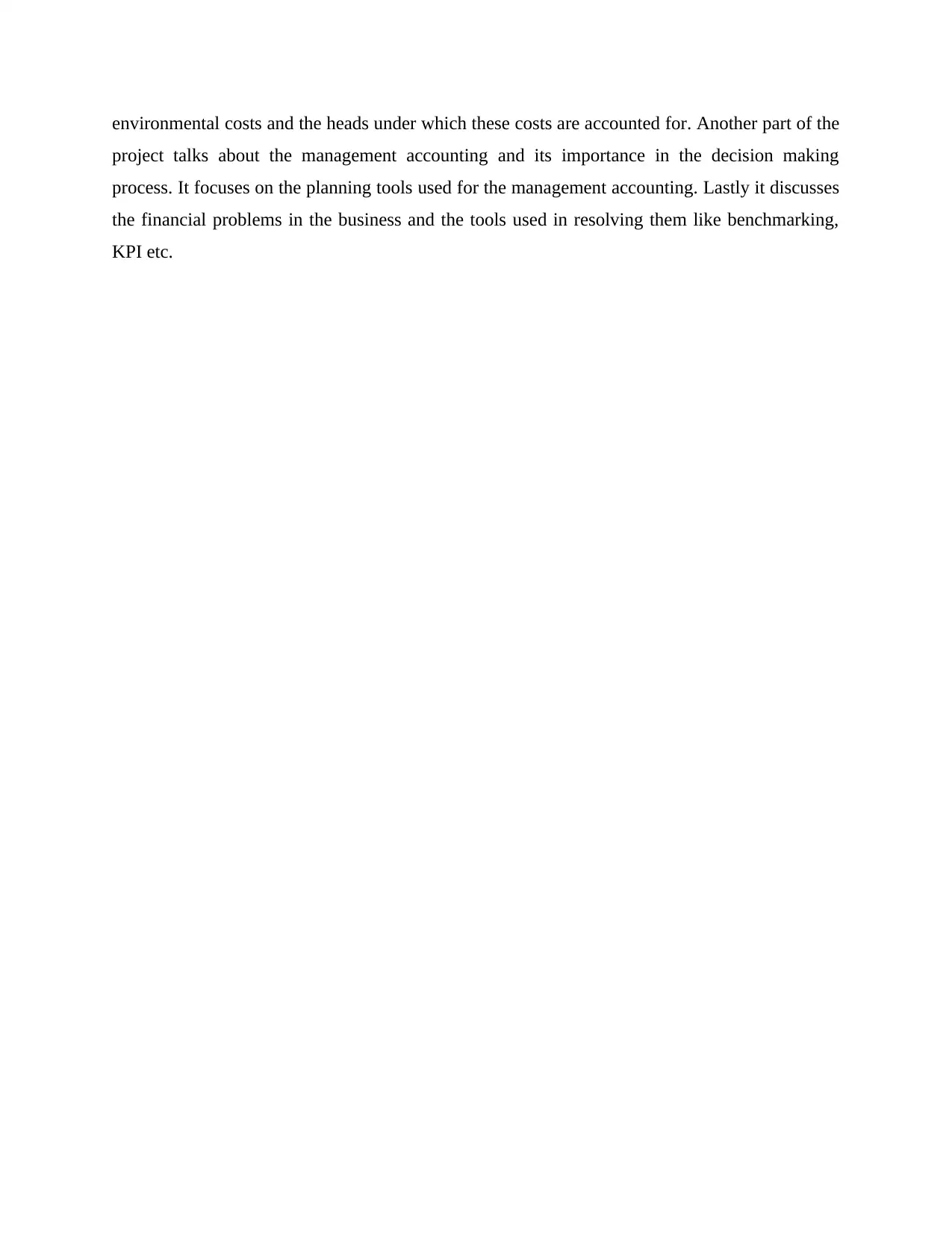
environmental costs and the heads under which these costs are accounted for. Another part of the
project talks about the management accounting and its importance in the decision making
process. It focuses on the planning tools used for the management accounting. Lastly it discusses
the financial problems in the business and the tools used in resolving them like benchmarking,
KPI etc.
project talks about the management accounting and its importance in the decision making
process. It focuses on the planning tools used for the management accounting. Lastly it discusses
the financial problems in the business and the tools used in resolving them like benchmarking,
KPI etc.
Paraphrase This Document
Need a fresh take? Get an instant paraphrase of this document with our AI Paraphraser

REFERENCES
Books and Journals
Gooneratne, T. N. and Hoque, Z., 2016. Institutions, agency and the institutionalization of
budgetary control in a hybrid state-owned entity. Critical perspectives on accounting.
36. pp. 58-70..
Johnstone, L., 2018. Theorising and modelling social control in environmental management
accounting research. Social and Environmental Accountability Journal. 38(1). pp.30-
48.
Langfield-Smith, K., Thorne, H. and Hilton, R. W., 2018. Management accounting: Information
for creating and managing value. Sydney: McGraw-Hill Education.
Latan, H. and et.al. 2018. Effects of environmental strategy, environmental uncertainty and top
management's commitment on corporate environmental performance: The role of
environmental management accounting. Journal of Cleaner Production. 180. pp.297-
306.
McCalmont, J. P. And et.al. 2017. Environmental costs and benefits of growing Miscanthus for
bioenergy in the UK. GCB Bioenergy. 9(3). pp.489-507.
McMullen, J. S. and Warnick, B. J., 2016. Should we require every new venture to be a hybrid
organization?. Journal of Management Studies. 53(4). pp.630-662.
Petera, P. and Šoljaková, L., 2020. Use of strategic management accounting techniques by
companies in the Czech Republic. Economic research-ekonomska istraživanja. 33(1).
pp. 46-67.
Qian, W., Hörisch, J. and Schaltegger, S., 2018. Environmental management accounting and its
effects on carbon management and disclosure quality. Journal of Cleaner
Production. 174. pp.1608-1619.
Schaltegger, S., 2018. Linking environmental management accounting: A reflection on (missing)
links to sustainability and planetary boundaries. Social and Environmental
Accountability Journal. 38(1). pp.19-29.
Schmitz, S. O., 2020. Budgetary Control–the Backbone of MCS. In The Future of Management
Control is Fair (pp. 13-29). Springer Gabler, Wiesbaden.
Schmitz, S. O., 2020. Budgetary Control–the Backbone of MCS. In The Future of Management
Control is Fair (pp. 13-29). Springer Gabler, Wiesbaden.
Uyar, A. and Kuzey, C., 2016. Does management accounting mediate the relationship between
cost system design and performance?. Advances in accounting. 35. pp.170-176.
Online
Advances in Environmental Accounting & Management. 2020. [Online]. Available through:
<https://www.emerald.com/insight/publication/issn/1479-3598>
Environmental Management Accounting: The Missing Link to Sustainability?. 2020. [Online].
Available through:
<https://www.tandfonline.com/doi/full/10.1080/0969160X.2018.1437057>
Books and Journals
Gooneratne, T. N. and Hoque, Z., 2016. Institutions, agency and the institutionalization of
budgetary control in a hybrid state-owned entity. Critical perspectives on accounting.
36. pp. 58-70..
Johnstone, L., 2018. Theorising and modelling social control in environmental management
accounting research. Social and Environmental Accountability Journal. 38(1). pp.30-
48.
Langfield-Smith, K., Thorne, H. and Hilton, R. W., 2018. Management accounting: Information
for creating and managing value. Sydney: McGraw-Hill Education.
Latan, H. and et.al. 2018. Effects of environmental strategy, environmental uncertainty and top
management's commitment on corporate environmental performance: The role of
environmental management accounting. Journal of Cleaner Production. 180. pp.297-
306.
McCalmont, J. P. And et.al. 2017. Environmental costs and benefits of growing Miscanthus for
bioenergy in the UK. GCB Bioenergy. 9(3). pp.489-507.
McMullen, J. S. and Warnick, B. J., 2016. Should we require every new venture to be a hybrid
organization?. Journal of Management Studies. 53(4). pp.630-662.
Petera, P. and Šoljaková, L., 2020. Use of strategic management accounting techniques by
companies in the Czech Republic. Economic research-ekonomska istraživanja. 33(1).
pp. 46-67.
Qian, W., Hörisch, J. and Schaltegger, S., 2018. Environmental management accounting and its
effects on carbon management and disclosure quality. Journal of Cleaner
Production. 174. pp.1608-1619.
Schaltegger, S., 2018. Linking environmental management accounting: A reflection on (missing)
links to sustainability and planetary boundaries. Social and Environmental
Accountability Journal. 38(1). pp.19-29.
Schmitz, S. O., 2020. Budgetary Control–the Backbone of MCS. In The Future of Management
Control is Fair (pp. 13-29). Springer Gabler, Wiesbaden.
Schmitz, S. O., 2020. Budgetary Control–the Backbone of MCS. In The Future of Management
Control is Fair (pp. 13-29). Springer Gabler, Wiesbaden.
Uyar, A. and Kuzey, C., 2016. Does management accounting mediate the relationship between
cost system design and performance?. Advances in accounting. 35. pp.170-176.
Online
Advances in Environmental Accounting & Management. 2020. [Online]. Available through:
<https://www.emerald.com/insight/publication/issn/1479-3598>
Environmental Management Accounting: The Missing Link to Sustainability?. 2020. [Online].
Available through:
<https://www.tandfonline.com/doi/full/10.1080/0969160X.2018.1437057>

⊘ This is a preview!⊘
Do you want full access?
Subscribe today to unlock all pages.

Trusted by 1+ million students worldwide
1 out of 12
Related Documents
Your All-in-One AI-Powered Toolkit for Academic Success.
+13062052269
info@desklib.com
Available 24*7 on WhatsApp / Email
![[object Object]](/_next/static/media/star-bottom.7253800d.svg)
Unlock your academic potential
Copyright © 2020–2025 A2Z Services. All Rights Reserved. Developed and managed by ZUCOL.





